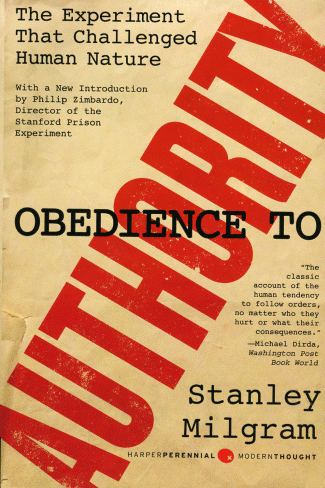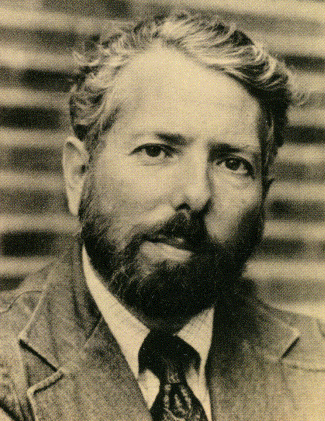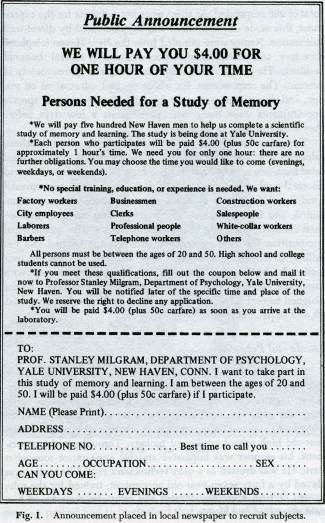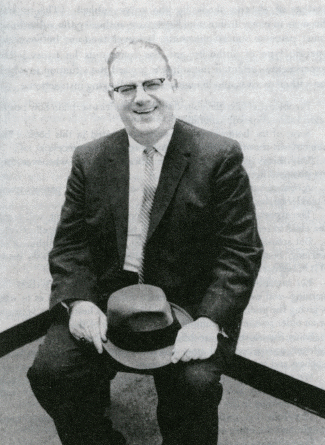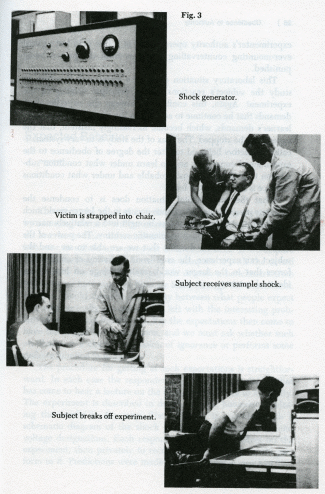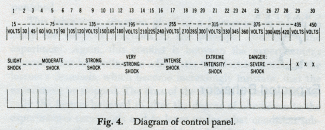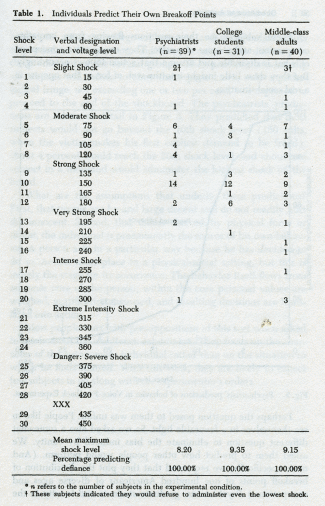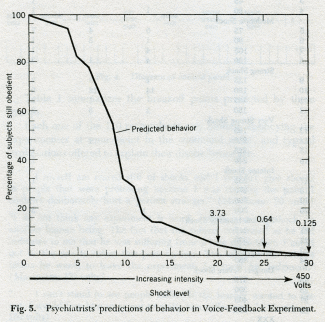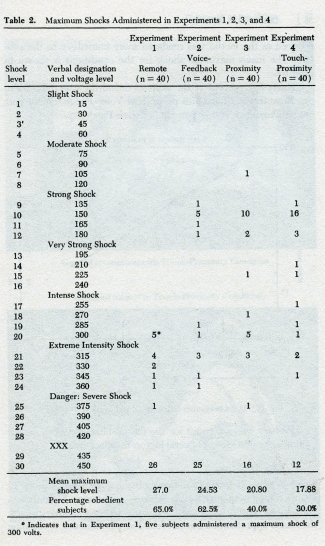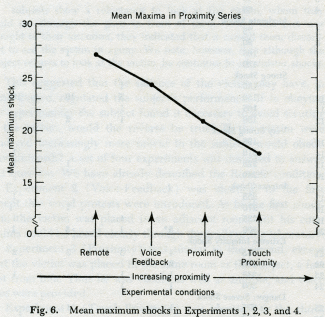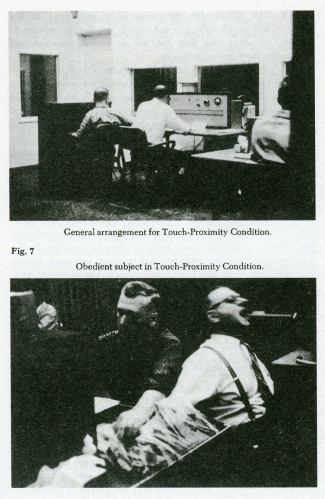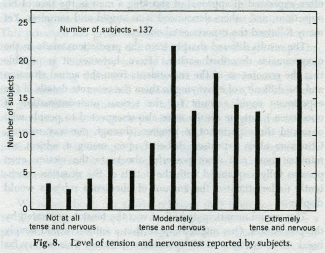5. Individuals Confront AuthorityFrom each person in the experiment we derive one essential fact: whether he has obeyed or disobeyed. But it is foolish to see the subject only in this way. For he brings to the laboratory a full range of emotions, attitudes, and individual styles. Indeed, so varied in temperament and manner are the people passing through the laboratory that it sometimes seems a miracle that we emerge with any regularities at all. One subject may be an inarticulate bricklayer, diffident and awkwardly humble in the presence of a scientist. He is followed by a self-assured, businessman, who thrusts his cigar at the experimenter to underscore his assertions.
We need to focus on the individuals who took part in the study not only because this provides a personal dimension to the experiment but also because the quality of each person’s experience gives us clues to the nature of the process of obedience.
We shall rely heavily on the participant’s own comments and assertions in building up the picture. At the same time a warning is in order. While we must take very seriously everything the subject says, we need not necessarily think that he fully understands the causes of his own behavior. A line must be drawn between listening carefully to what the subject says and mistaking it for the full story. The subject is controlled by many forces in the situation beyond his awareness, implicit structures that regulate his behavior without signaling this fact to him, And we have one enormous advantage over the subject: In each condition, we have slightly varied the nature of the circumstances which the subject confronts and thus know the importance of each of the factors. The participant, and he alone, has experienced the predicament, but he cannot place it in the perspective that comes only from an overview.
The sources of information are, first, our observation of the individual as he performs in the experiment in particular, the dialogue arising between him and the experimenter. Additionally, all subjects provided information on their background in a post- experimental interview (we have changed their names in the following accounts). Finally, a number of subjects took part in individual and group discussions, led by a member of the Yale School of Psychiatry.
Bruno Batta, Welder (in Experiment 4)Mr. Batta is a thirty-seven-year-old welder. He was born in New Haven, his parents in Italy. He has a rough-hewn face that conveys a conspicuous lack of alertness. His over-all appearance is somewhat brutish. An observer described him as a “crude mesomorph of obviously limited intelligence.” But this is not fully adequate, for he relates to the experimenter with a submissive and deferential sweetness.
He has some difficulty in mastering the experimental procedure and needs to be corrected by the experimenter several times. He shows appreciation for the help and willingness to do what is required. The experiment is the Touch-Proximity variation. After the 150-volt level, Batta has to force the learner’s hand down on the shock plate, since the learner himself refuses to touch it.
When the learner first complains, Mr. Batta pays no attention to him. His face remains impassive, as if to dissociate himself from the learner’s disruptive behavior. When the experimenter instructs him to force the learner’s hand down, he adopts a rigid mechanical procedure. He tests the generator switch. When it fails to function, he immediately forces the learner’s hand onto the shock plate. All the while he maintains the same rigid mask. The learner, seated alongside him, begs him to stop, but with robotic impassivity, he continues the procedure. What is extraordinary is his apparent total indifference to the learner; he hardly takes cognizance of him as a human being. Meanwhile, he relates to the experimenter in a submissive and courteous fashion.
At the 330-volt level, the learner refuses not only to touch the shock plate but also to provide any answers. Annoyed, Batta turns to him, and chastises him: “You better answer and get it over with. We can’t stay here all night.” These are the only words he directs to the learner in the course of the hour. Never again does he speak to him. The scene is brutal and depressing: his hard, impassive face showing total indifference as he subdues the screaming learner and gives him shocks. He seems to derive no pleasure from the act itself, only quiet satisfaction at doing his job properly.
When he administers 450 volts, he turns to the experimenter and asks, “Where do we go from here, Professor?” His tone is deferential and expresses his willingness to be a cooperative subject, in contrast to the learner’s obstinacy.
In the post experimental interview, he gives a jumbled account of the experiment. The experimenter routinely asks him whether the experiment has any other purpose he can think of. He uses the question, without any particular logic, to denigrate the learner, stating, “Well, we have more or less a stubborn person (the learner). If he understood what this here was, he would'a went along without getting the punishment.” In his view, the learner brought punishment on himself.
The experimenter asks whether he felt tense or nervous during the experiment. Again, he uses the question to express his feelings toward the learner. “The only time I got a little -- I wouldn’t say nervous -- I got disgusted, is when he wouldn’t cooperate.” The experimenter has great difficulty in questioning the subject on the issue of responsibility. He does not seem to grasp the concept.
The interviewer simplifies the question. Finally the subject assigns major responsibility to the experimenter: “I say your fault for the simple reason that I was paid for doing this. I had to follow orders. That’s how I figured it.”
Then, assigning all possibilities of initiative to the experimenter, he says, “Now you could have just as soon said, ‘Now look, gimme the money back and we’ll forget about this thing.' Then we could have made up our own minds.”
We note that while for many subjects offering to return the payment is regarded as an honorable means of withdrawing from the experiment, this subject can only conceive of the act if initiated by the authority. The experimenter rejoins, “But I told you the money was yours simply for coming, no matter what happened.”
“That’s right.”
At the end of the session, he tells the experimenter how honored he has been to help him, and in a moment of contrition, remarks, “Sir, sorry it couldn’t have been a full experiment.”
He has done his honest best. It is only the deficient behavior of the learner that has denied the experimenter full satisfaction.
In a questionnaire returned by Mr. Batta several months later, he informs us that he followed the experimenter’s instructions to the end, that he fully believed the learner was getting painful shocks, and that the experiment has not bothered him at all. He believes more experiments of this sort should be carried out, and he answers “yes” to our question of whether he has learned something of personal value. But he does not tell us what.
Professor of Old Testament (in Experiment 3)A somewhat gaunt, ascetic man, this subject could be taken for a New England minister. In fact, he teaches Old Testament liturgy at a major divinity school. In this Proximity condition, he adjusted his seat to look at the learner while administering shocks. While reading the word pairs, he employs exaggerated precision in his pronunciation, and seems curt and officious in saying, “Correct.” Whenever the learner makes an error, he appears almost to be chastising him for his failing. Each time he administers a shock, his lips are drawn back, and he bares his teeth. An excessive fastidiousness characterizes all his actions. After administering 150 volts he balks at going further. The experimenter states that the learner’s protests are to be disregarded, and the experiment must continue:
EXPERIMENTER: Its absolutely essential to the experiment that we continue.
SUBJECT: I understand that statement, but I don’t understand why the experiment is placed above this person’s life.
EXPERIMENTER: There is no permanent tissue damage.
SUBJECT: Well, that’s your opinion. If he doesn’t want to continue, I’m taking orders from him.
EXPERIMENTER: You have no other choice, sir, you must go on.
SUBJECT: If this were Russia maybe, but not in America. (The experiment is terminated.)
In his discussion with the experimenter, the subject seems in no way intimidated by the experimenter’s status but rather treats him as a dull technician who does not see the full implications of what he is doing. When the experimenter assures him of the safety of the shock generator, the subject, with some exasperation, brings up the question of the emotional rather than physiological effects on the learner.
SUBJECT (spontaneously): Surely you’ve considered the ethics of this thing. (extremely agitated) Here he doesn’t want to go on, and you think that the experiment is more important? Have you examined him? Do you know what his physical state is? Say this man had a weak heart (quivering voice).
EXPERIMENTER : We know the machine, sir.
SUBJECT: But you don’t know the man you’re experimenting on. That’s very risky (gulping and tremulous). What about the fear that man had? It’s impossible for you to determine what effect that has on him….. the fear that he himself is generating. But go ahead, you ask me questions; I’m not here to question you.
He limits his questioning, first because he asserts he does not have a right to question, but one feels that he considers the experimenter too rigid and limited a technician to engage in intelligent dialogue. One notes further his spontaneous mention of ethics, raised in a didactic manner and deriving from his professional position as teacher of religion. Finally, it is interesting that he initially justified his breaking off the experiment not by asserting disobedience but by asserting that he would then take orders from the victim.
Thus, he speaks of an equivalence between the experimenter’s and the learner’s orders and does not disobey so much as shifts the person from whom he will take orders.
After explaining the true purpose of the experiment, the experimenter asks, “What in your opinion is the most effective way of strengthening resistance to inhumane authority?”
The subject answers, “If one had as one’s ultimate authority God, then it trivializes human authority.”
Again, the answer for this man lies not in the repudiation of authority but in the substitution of good -- that is, divine -- authority for bad.
Jack Washington, Drill Press Operator (in Experiment 2)Jack Washington is a black subject, age thirty-five, who was born in South Carolina. He works as a drill press operator and stresses the fact that although he did not complete high school, he was not a dropout but was drafted into the army before he could get his diploma. He is a soft man, a bit heavy and balding, older-looking than his years. His pace is very slow and his manner impassive; his speech is tinged with Southern and black accents.
When the victim’s first protests are heard, he turns toward the experimenter, looks sadly at him, then continues reading the word pairs. The experimenter does not have to tell him to continue. Throughout the experiment he shows almost no emotion or bodily movement. He does what the experimenter tells him in a slow, steady pace that is set off sharply against the strident cries of the victim. Throughout, a sad, dejected expression shows on his face. He continues to the 450-volt level, asks the experimenter what he is to do at that point, administers two additional shocks on command, and is relieved of his task.
He explains in the interview that although he feels the shocks were extremely painful, he accepted the experimenter’s word that they would cause no permanent damage. He reaffirms this belief in a questionnaire answered almost a year after his participation. When asked about responsibility for the victim’s suffering, he places the heaviest burden on the experimenter, then on the victim, and assigns the least to himself. Of the learner he says, “He agreed to it, and therefore must accept responsibility.” The experimenter has “the biggest share of the responsibility. I merely went on. Because I was following orders I was told to go on. And I did not get a cue to stop.
He becomes enmeshed in this formulation which he repeats several times. He explains to the experimenter that if he had received a cue from the experimenter, he would have stopped, implying that he would behave in whatever manner the experimenter required. The only dereliction he can conceive of in the situation is that of not obeying the experimenter.
He explains in his slow, steady manner, “I know that up to a certain point a shock won’t kill you. I had a shock to the point where I was almost knocked down.... My whole hand was numb. But it didn’t kill me.”
Thus, he indicates acceptance of the experimenter’s statement that the shocks may be painful but are not dangerous. In all respects he expresses total faith in the experimenter and indeed accepts his authority more easily and with less inner conflict than many subjects.
Jan Rensaleer, Industrial Engineer (in Experiment 2)The subject is a thirty-two-year-old industrial engineer, sporting blond hair and a mustache. He is self-contained and speaks with a trace of a foreign accent. He is neatly dressed. In the interview he tells us that he emigrated from Holland after the Second World War and that he is a member of the Dutch Reformed Church. He is mild-mannered and intelligent.
When the victim complains at the 150-volt level, the subject turns to the experimenter and asks, “What do I do now?”
The experimenter tells him to continue.
The engineer presses his hand to his head and proceeds with the test. He glances more and more often at the experimenter. At 255 volts, he pushes the chair away from the shock generator and turns to the experimenter:
MR. RENSALEER: Oh, I can’t continue this way; it’s a voluntary program, if the man doesn’t want to go on with it.
EXPERIMENTER: Please continue.
(A long pause.)
MR. RENSALEER: No, I can’t continue. I’m sorry.
EXPERIMENTER: The experiment requires that you go on.
MR. RENSALEER: The man, he seems to be getting hurt.
EXPERIMENTER: There is no permanent tissue damage.
MR. RENSALEER: Yes, but I know what shocks do to you. I’m an electrical engineer, and I have had shocks … and you get real shook up by them -- especially if you know the next one is coming. I’m sorry.
EXPERIMENTER: It is absolutely essential that you continue.
MR. RENSALEER: Well, I won’t -- not with the man screaming to get out.
EXPERIMENTER: You have no other choice.
MR. RENSALEER: I do have a choice. (Incredulous and indignant:) Why don’t I have a choice? I came here on my own free will. I thought I could help in a research project. But if I have to hurt somebody to do that, or if I was in his place, too, I wouldn’t stay there. I can’t continue. I’m very sorry. I think I’ve gone too far already, probably.
When asked who was responsible for shocking the learner against his will, he said, “I would put it on myself entirely.”
He refused to assign any responsibility to the learner or the experimenter.
“I should have stopped the first time he complained. I did want to stop at that time. I turned around and looked at you. I guess it’s a matter of ... authority, if you want to call it that: my being impressed by the thing, and going on although I didn’t want to. Say, if you’re serving in the army, and you have to do something you don’t like to do, but your superior tells you to do it. That sort of thing, you know what I mean?"
"One of the things I think is very cowardly is to try to shove the responsibility onto someone else. See, if I now turned around and said, ‘It’s your fault ... it’s not mine,’ I would call that cowardly.”
Although this subject defied the experimenter at 255 volts, he still feels responsible for administering any shocks beyond the victim’s first protests. He is hard on himself and does not allow the structure of authority in which he is functioning to absolve him of any responsibility.
Mr. Rensaleer expressed surprise at the underestimation of obedience by the psychiatrists. He said that on the basis of his experience in Nazi-occupied Europe, he would predict a high level of compliance to orders. He suggests, “It would be interesting to conduct the same tests in Germany and other countries.” [3]
The experiment made a deep impression on the subject, so much so that a few days after his participation he wrote a long, careful letter to the staff, asking if he could work with us.
“Although I am ... employed in engineering, I have become convinced that the social sciences and especially psychology, are much more important in today’s world.”
Morris Braverman, Social Worker (in Experiment 2)Morris Braverman is a thirty-nine-year-old social worker. He looks older than his years because of his bald pate and serious demeanor. His brow is furrowed, as if all the world’s burdens were carried in his face. He appears intelligent and concerned. The impression he creates is that of enormous overcontrol, that of a repressed and serious man, whose finely modulated voice is not linked with his emotional life. He speaks impressively but with perceptible affectation. As the experiment proceeds, laughter intrudes into his performance. At first, it is a light snicker, then it becomes increasingly insistent and disruptive. The laughter seemed triggered by the learner’s screams.
When the learner refuses to answer and the experimenter instructs him to treat the absence of an answer as equivalent to a wrong answer, he takes his instruction to heart.
Before administering 315 volts he asserts officiously to the victim, “Mr. Wallace, your silence has to be considered as a wrong answer.” Then he administers the shock. He offers half-heartedly to change places with the learner, then asks the experimenter, “Do I have to follow these instructions literally?” He is satisfied with the experimenter’s answer that he does. His very refined and authoritative manner of speaking is increasingly broken up by wheezing laughter.
The experimenter’s notes on Mr. Braverman at the last few shocks are:
Almost breaking up now each time gives shock. Rubbing face to hide laughter.
Ratting eyes, trying to hide face with hand, still laughing.
Cannot control his laughter at this point no matter what he does.
Clenching fist pushing it onto table.
In the interview, Mr. Braverman summarizes the experiment with impressive fluency and intelligence. He feels the experiment may have been designed also to “test the effects on the teacher of being in an essentially sadistic role, as well as the reactions of a student to a learning situation that was authoritative, rigid, and punitive.” When asked how painful the last few shocks administered to the learner were, he indicates that the most extreme category on the scale is not adequate (it read EXTREMELY PAINFUL) and places his mark at the extreme edge of the scale with an arrow carrying it beyond the scale.
It is almost impossible to convey the extremely relaxed, sedate quality of his conversation in the interview. In the most quiescent terms, he speaks about his extreme inner tension.
EXPERIMENTER: At what point were you most tense or nervous?
MR. BRAVERMAN: Well, when he first began to cry out in pain, and I realized this was hurting him. This got worse when he just blocked and refused to answer. There was I. I’m a nice person, I think, hurting somebody, and caught up in what seemed a mad situation and in the interest of science, one goes through with it. At one point I had an impulse to just refuse to continue with this kind of a teaching situation.
EXPERIMENTER: At what point was this?
MR. BRAVERMAN: This was after a couple of successive refusals and silences. This is when I asked you a question as to whether I have a choice in my teaching method. At this point my impulse was to plead with him, talk with him, encourage him, try to ally myself with his feelings, work at this so we could get this through together and I wouldn’t have to hurt him.
When Mr. Braverman states that he considered “not going through with it,” he does not mean that he considered disobeying but rather that he considered modifying the manner of teaching the victim.
When the interviewer brings up the general question of tension, Mr. Braverman spontaneously mentions his laughter.
“My reactions were awfully peculiar. I don’t know if you were watching me, but my reactions were giggly, and trying to stifle laughter. This isn’t the way I usually am. This was a sheer reaction to a totally impossible situation. And my reaction was to the situation of having to hurt somebody. And being totally helpless and caught up in a set of circumstances where I just couldn’t deviate and I couldn’t try to help. This is what got me.”
A year after his participation in the experiment, he affirms in the questionnaire that he has definitely learned something of personal importance as a result of being in the experiment, adding: “What appalled me was that I could possess this capacity for obedience and compliance to a central idea, i.e. the value of a memory experiment even after it became clear that continued adherence to this value was at the expense of violation of another value, i.e. don’t hurt someone else who is helpless and not hurting you. As my wife said, ‘You can call yourself Eichmann.’ I hope I can deal more effectively with any future conflicts of values I encounter.”
